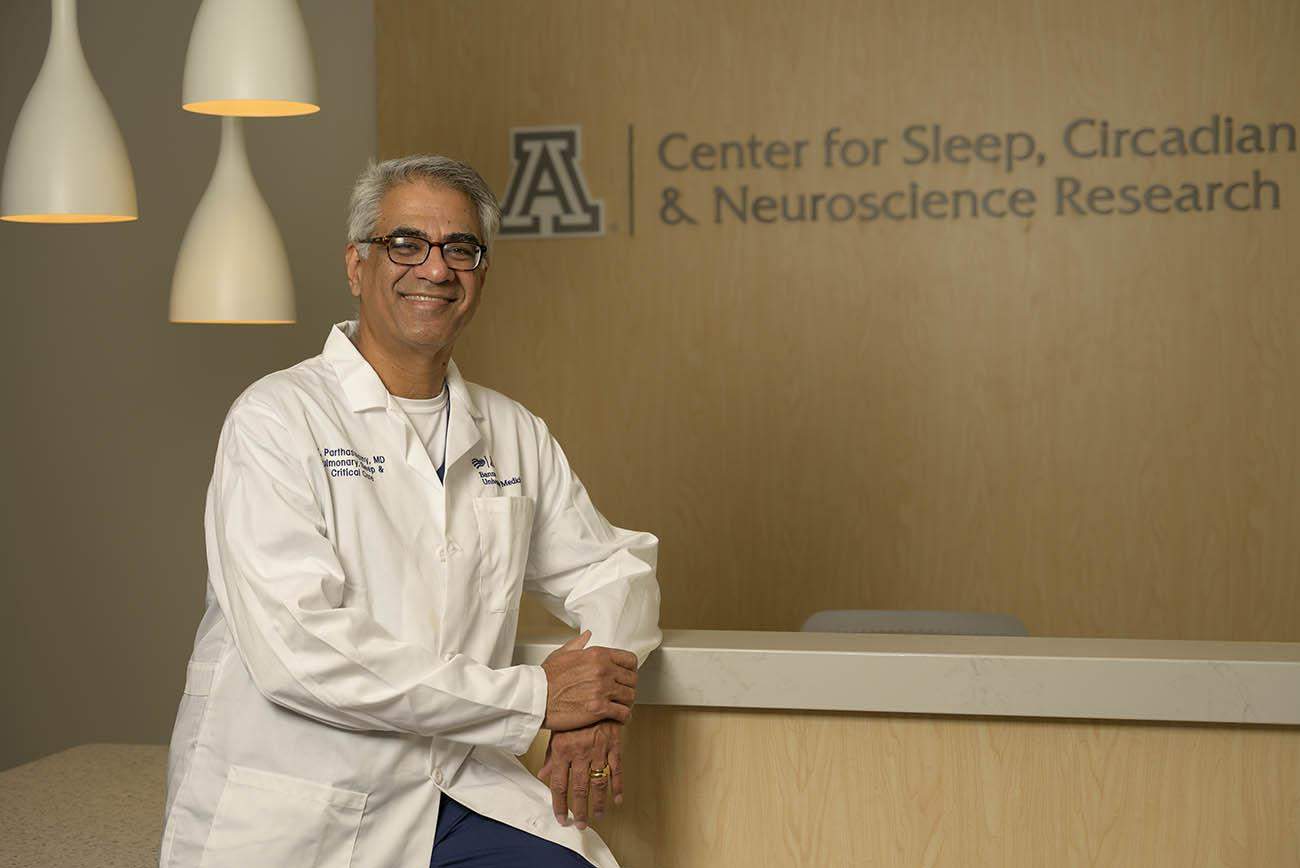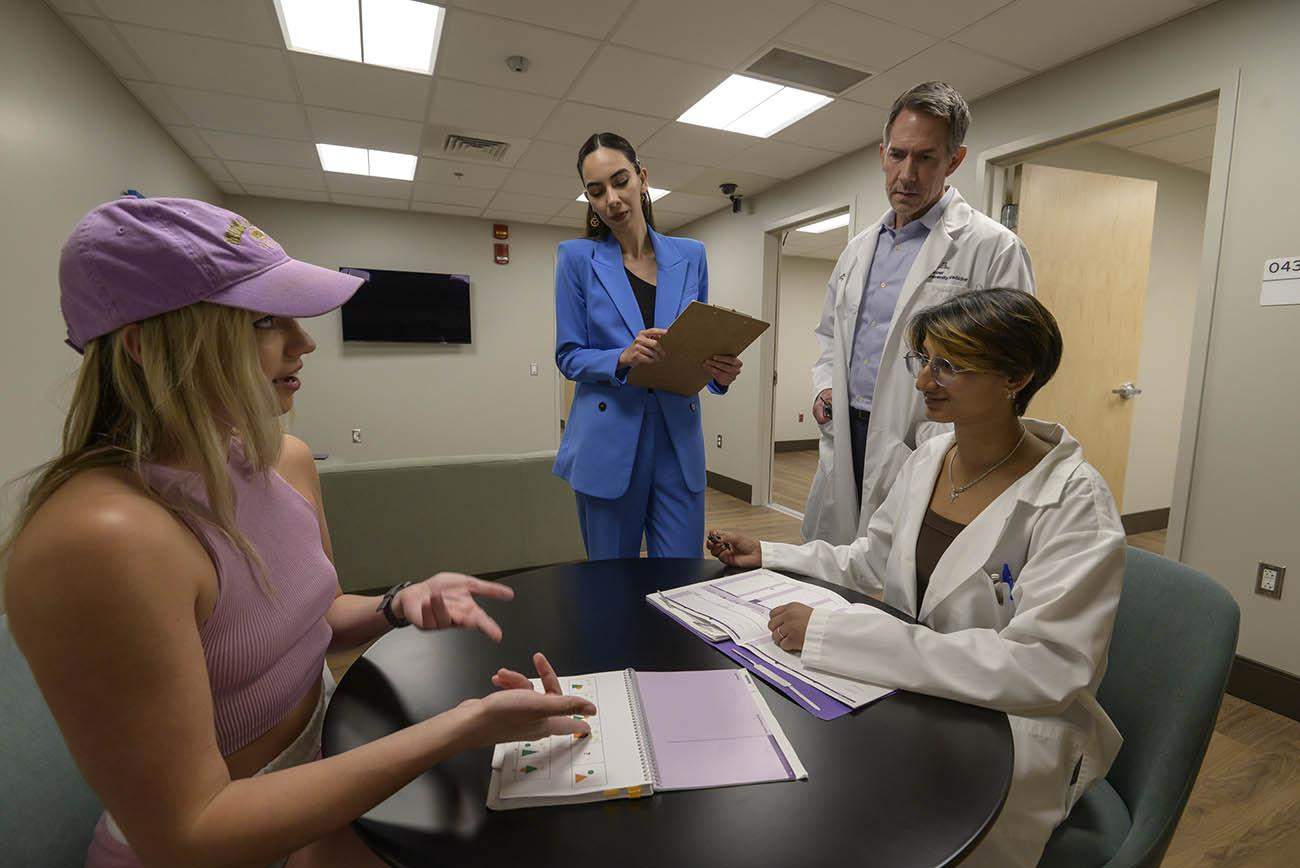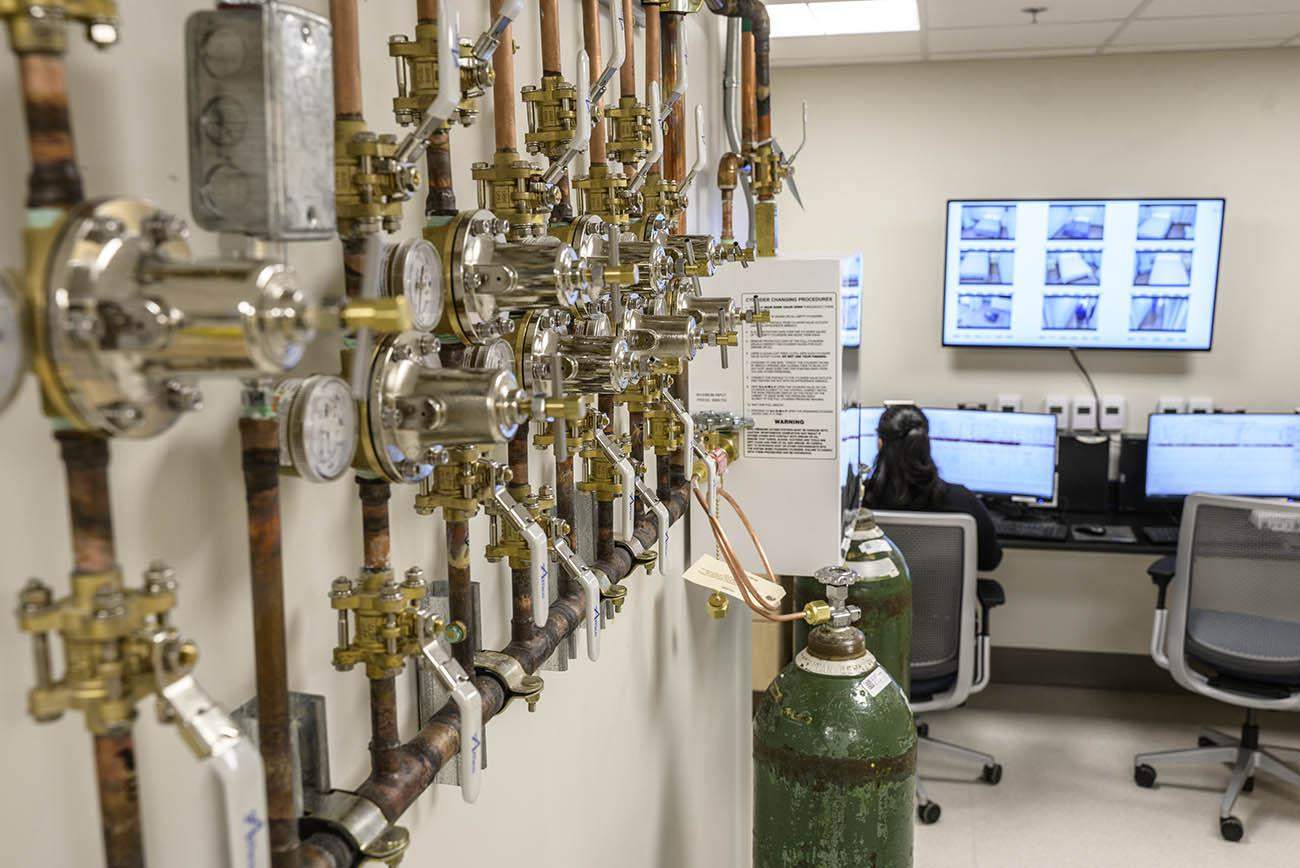Sairam Parthasarathy, MD, director of the University of Arizona Health Sciences Center for Sleep, Circadian and Neuroscience Research, reviews test data in the control room of the center’s new facility with lead sleep technologist Sicily La Rue.
The University of Arizona Health Sciences Center for Sleep, Circadian and Neuroscience Research gives researchers a world-class, one-of-a-kind facility to study the impacts of sleep and circadian rhythm on everything from cognition to the body’s response during interplanetary travel.
 The center’s new facility, funded by a $5 million construction grant from the National Institutes of Health Office of the Director, opens today, May 15. Its 12,700 square feet of highly controlled environment will allow state-of-the-art, highly innovative research that would not be feasible elsewhere, said center director Sairam Parthasarathy, MD, chief of the Division of Pulmonary, Allergy, Critical Care and Sleep Medicine at the University of Arizona College of Medicine – Tucson.
The center’s new facility, funded by a $5 million construction grant from the National Institutes of Health Office of the Director, opens today, May 15. Its 12,700 square feet of highly controlled environment will allow state-of-the-art, highly innovative research that would not be feasible elsewhere, said center director Sairam Parthasarathy, MD, chief of the Division of Pulmonary, Allergy, Critical Care and Sleep Medicine at the University of Arizona College of Medicine – Tucson.
“Our center is one of a kind,” Dr. Parthasarathy said. “The ability to control, manipulate and measure the temperature, lighting intensity and timing, and inhaled gases, and collect blood samples and administer intravenous medications remotely in one single facility is, to our knowledge, not feasible in any other sleep-circadian research center in the U.S.”
“This facility will further cement the University of Arizona Health Sciences’ position as a leader in sleep research,” said Michael D. Dake, MD, senior vice president for the University of Arizona Health Sciences. “This will enhance our cutting-edge human sleep and circadian rhythms research to advance our understanding of disease processes involving multiple biological systems. Sleep and circadian rhythms can influence the gamut of health from the cellular level to organ systems to behavioral health and severe mental illnesses. It also impacts public health and safety at the macroscopic level, for instance traffic accidents caused by sleep impairment.”
Controlling every last detail
 The original Center for Sleep and Circadian Sciences, established in 2015, was an off-campus four-bed leased research space that lacked the environmental controls necessary for many research projects. For example, ambient light intensity and frequency, sound, or temperature could not be controlled with the level of fidelity required for sophisticated studies.
The original Center for Sleep and Circadian Sciences, established in 2015, was an off-campus four-bed leased research space that lacked the environmental controls necessary for many research projects. For example, ambient light intensity and frequency, sound, or temperature could not be controlled with the level of fidelity required for sophisticated studies.
The new eight-bedroom facility, located in the lower level of a former Banner – University Medical Center Tucson building, will allow for continuous monitoring of the environment in each room using sensors for light, noise, room, core body and skin temperatures, and inhaled gases, all of which will be collected and recorded with date and time stamps in a synchronous manner with the sleep and circadian rhythms in computerized software. The rooms also allow for remotely sampling blood or the administration of medications through IV tubing leading to a control room, meaning researchers won’t need to disturb the test subject to get samples.
“I am most excited about the new scientific questions we can explore with a facility such as this,” said the center’s associate director Michael Grandner, PhD, MTR, CBSM, FAASM, assistant professor and director of the Sleep and Health Research Program in the College of Medicine – Tucson’s Department of Psychiatry.
“We already have projects planned that have the potential to answer questions about how sleep contributes to heart health, why our brains crave unhealthy foods in the middle of the night, how the rhythms of suicide can teach us how to prevent it, how we can use wearables to improve population sleep health, and how we can use neuroscience to reduce racial and ethnic sleep disparities.”
Expanding research capabilities
Along with the new facility, the center added “Neuroscience Research” to its name to highlight the connection between sleep, circadian rhythms and neuroscience. “This more inclusive name highlights the work of researchers who are studying and exploring mechanisms by which sleep and circadian rhythms can influence cognition,” Dr. Parthasarathy said.
 Research has highlighted the connection between sleep-circadian disorders and other conditions such as cancer, pain, cardiovascular disease, cognition, mental health and even long COVID. In fact, the 2017 Nobel Prize in Physiology or Medicine was awarded for the discovery of the molecular mechanisms controlling circadian rhythms – the body’s ability to adapt to the rotation of the planet and the cellular clock machinery of every cell in the human body.
Research has highlighted the connection between sleep-circadian disorders and other conditions such as cancer, pain, cardiovascular disease, cognition, mental health and even long COVID. In fact, the 2017 Nobel Prize in Physiology or Medicine was awarded for the discovery of the molecular mechanisms controlling circadian rhythms – the body’s ability to adapt to the rotation of the planet and the cellular clock machinery of every cell in the human body.
“The number of researchers within and outside the sleep-circadian rhythms space who are interested in pursuing research in this arena has increased,” Dr. Parthasarathy said. “We are proposing more complex studies that require certain things, such as remote and frequent blood sampling during a 24-hour period that includes the sleep period, remote delivery of medications, simulation of the International Space Station or even the Mars mission, and manipulation of inhaled gases to mimic global warming and greater CO2 emissions.”
Increased collaboration and impact
William D. “Scott” Killgore, PhD, a member of the executive committee for the new center and a professor of psychiatry with additional appointments in psychology and medical imaging in the College of Medicine – Tucson, said the new center will greatly increase the university’s impact in the field of sleep and circadian science.
 “The monitoring capabilities of the new center are light years ahead of where we were in the old facility,” said Dr. Killgore, who is the director of the Social, Cognitive, and Affective Neuroscience (SCAN) Lab in the Department of Psychiatry and a member of the BIO5 Institute.
“The monitoring capabilities of the new center are light years ahead of where we were in the old facility,” said Dr. Killgore, who is the director of the Social, Cognitive, and Affective Neuroscience (SCAN) Lab in the Department of Psychiatry and a member of the BIO5 Institute.
“It will now be possible to run large multi-person sleep deprivation and circadian shift studies faster than before and to have much greater control over nearly every aspect of the living environment, including the ability to transport participants directly to the research neuroimaging center without having to be exposed to outside light or temperature changes. The center is large enough to accommodate multiple investigators and research teams operating simultaneously, which will dramatically increase the impact of University of Arizona research on the field of sleep and circadian science.”
The university has a long history of sleep research going back to the early 1980s. Currently, collaborative sleep and circadian research involves 18 investigators from five colleges and nine departments within UArizona Health Sciences.
The center also supports researchers across the university, including in the colleges of Science, Education and Agriculture and Life Sciences. This research is supported in part by more than $20 million in funding from the National Institutes of Health, Patient Centered Outcomes Research Institute, the U.S. Department of Defense, and various foundations and industries.
“This facility will allow us to conduct time-isolation research where individuals are cut off from all time cues,” Dr. Grandner said. “This allows us to study circadian rhythms and the timing mechanisms in our body that control so many important functions. Some of these are related to sleep, but really, this opens the door to studying biological rhythms in a completely new way.”
Photos courtesy of UArizona Health Sciences Office of Communications - Kris Hanning. Mouseover images to see captions.
Enhanced research options at the new center
The new facility enables the following research enhancements:
- Perform “time isolation studies” that simulate various conditions, which allows for the study of the true nature of an individual’s circadian rhythm without the influence of sunlight and other extraneous stimuli that can alter circadian rhythms
- Simulate the lighting in the International Space Station or even the Mars mission and better understand the effects of such space travel on sleep and circadian rhythms
- Manipulate inhaled gases to mimic greater CO2 emissions and better understand the effects of global warming on sleep-circadian rhythms
Allow for a deeper study of sleep-circadian rhythms by remotely sampling blood through IV tubing and a sealed conduit from a control room without disturbing the participant in order to understand the effects of sleep-circadian rhythms on body metabolism and other changes over a 24-hour period
- Administer medications over a 24-hour period without disturbing the participant’s sleep-circadian rhythms
- Support extended studies to study sleep-circadian rhythms and the consequences of perturbing or enhancing with the aid of various interventions
- Support research studies that require proximity to brain imaging facilities without exposure to sunlight or other circadian altering factors
- Process and store biological samples in a Biosafety Level 2 wet laboratory proximal to the sleep suites
- Ability to measure time synchronized infrared audio/video with a multitude of polysomnography signals that include brain waves to measure sleep and circadian rhythms, breathing, oxygen and carbon dioxide concentration, respiratory effort, electrocardiogram, eye movements, muscle activity, and other physiological sensors
- Ability to monitor and store temperature, gas concentrations, and light intensity, frequency and timing information for analyses
- Facilitate the assessment of wakefulness, neurocognitive testing and informed consenting in seven sound-proofed rooms
- Conduct community outreach and other activities in a community engagement area aimed at promoting health literacy


